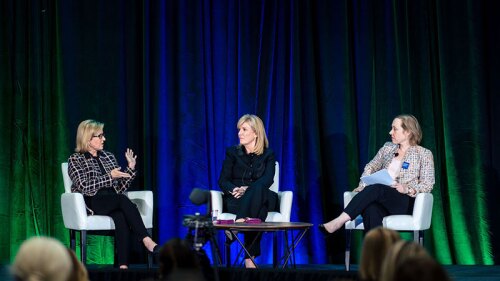Leonardo da Vinci could not have captured all of Chicago in a single drawn image. Offered here is not the codexChicago, but a brief visual guide to some highlights that help readers follow up on the structures mentioned in this issue’s articles about Chicago—host to the ULI Fall Meeting in November.
The map includes a few examples of the city’s iconic architecture, including the Willis Tower (originally known as the Sears Tower, and still the city’s tallest skyscraper) and the John Hancock Center. Two newer additions to the list of the city’s most innovative skyscrapers—the Trump International Hotel & Tower and the Aqua Tower—represent a slice of what is going on in the booming hotel market. As discussed in “Checking In,” which begins on page 76, these structures reflect cutting-edge examples of mixed-use development, including hotel units, residences, and office and retail spaces.
Many of the map sites are discussed in “Chicago in Plan,” which begins on page 72. Written exclusively for Urban Land by the authors of Planning Chicago, this article explains how McCormick Place—the site of ULI’s Fall Meeting—came to be built where it is. The book’s authors, Jon B. DeVries and D. Bradford Hunt, offer suggestions on how the convention site, far removed from the heart of downtown, could be better integrated with nearby neighborhoods—the Motor Row Historic District and Chinatown—to create a walkable, enriching experience for visitors. DeVries and Hunt also offer insights into the creation of several of Chicago’s jewels, including the campus that links the Field Museum of Natural History, the John G. Shedd Aquarium, and the Adler Planetarium. (If you visit, take a glance toward the east, to Northerly Island, site of an ambitious development plan to turn the old Meigs Field airstrip into a lakefront public space with a concert pavilion, wetlands, and a lagoon. It is being designed by JJR landscape architects and Studio/Gang/Architects.)
DeVries and Hunt point out their workplace, Roosevelt University Vertical Campus, which turns the traditional campus footprint on its side, extending 32 stories high in the south Loop. The authors also note how the reuse of land formerly dedicated to railroads is a theme running through many of Chicago development stories. The map shows how the city remains marbled with rail lines, along with the site of bustling Chicago Union Station.
Across the street from McCormick Place lies Lakeside Technology Center. Formerly a printing plant, the building has been converted into a data center. See “The City of Big Servers,” which begins on page 92, for more on why Chicago is particularly well suited for these centers.
Also, to the lower left of the map, you will find the Pilsen neighbor hood highlighted. The historic Latino neighborhood has been at the center of a vibrant arts, education, and community redevelopment effort. It will be a focus of a meeting session on Thursday morning, November 7, and is just one example of the many Chicago neighborhoods that will be presented in-depth through meeting sessions, mobile workshops, and special-interest tours.
—Elizabeth Razzi
Map Key
1. John Hancock Center. At 1,128 feet (344 m), it is the third-tallest building in the city. It was designed by Skidmore, Owings & Merrill (SOM) and developed by Jerry Wolman Associates.2. Navy Pier. Built in 1916, it is on the National Register of Historic Places and is a top tourist attraction. It was the focus of ULI Advisory Services panels in 1989 and 2010.3. Aqua Tower. At 859 feet (262 m), it is the tenth-tallest structure in Chicago. The novel design is by Studio/Gang/Architects and Loewenberg Architects. It contains residences and hotel space.4. Millennium Park. Consisting of 24.5 acres (10 ha), the park was built above commuter rail yards. Completed in 2004, it is home to notable public works of art and architecture, including the Cloud Gate sculpture (known as “the bean”) by Anish Kapoor and the Jay Pritzker Music Pavilion designed by Frank Gehry.5.Clarence F. Buckingham Memorial Fountain. From April through mid-October, it produces a 20-minute water show every hour, with the center jet shooting 150 feet (45.7 m) high. Designed by Edward H. Bennett, it was dedicated in 1927.6. Roosevelt University Vertical Campus. The 32-story, $123 million edifice opened in 2012 and is the second-tallest university building in the United States. It houses classrooms, laboratories, offices, dorm rooms, a dining hall, and fitness facilities.7. The Field Museum of Natural History, 8. the Shedd Aquarium, and 9. Adler Planetarium. The museums are linked by the 57-acre (23 ha) Museum Campus, which creates a pedestrian-friendly area.10. Soldier Field. Home of the Chicago Bears, the stadium, completed in 1921, is the oldest in the National Football League. The United Club at Soldier Field will be the site of a reception during the 2013 ULI Fall Meeting.11. Lakeside Technology Center. This former printing plant is a major data center.12. McCormick Place. Opened in 1960 and updated subsequently, this convention facility is the nation’s largest, with 2.6 million square feet (111,500 sq m) of exhibit space.13. Chinatown and 14. Pilsen, neighborhoods historically populated by Chinese and Latino residents, respectively, and near the McCormick Place convention complex.15. Chicago Union Station. Opened in 1925, it handles intercity and commuter rail lines. The station is being considered for renovation.16. Willis Tower. Formerly known as the Sears Tower, it remains the tallest completed skyscraper in the United States, at an architectural height of 1,451 feet (442 m). The office building, designed by SOM, was completed in 1974. One World Trade Center in New York City will surpass Willis Tower with 1,776 feet (541 m) when completed in 2014.17. Trump International Hotel and Tower. At 1,389 feet (423 m), this 98-story residence and hotel is the second-tallest structure in Chicago. It was completed in 2009 and was designed by SOM for the Trump Organization.


